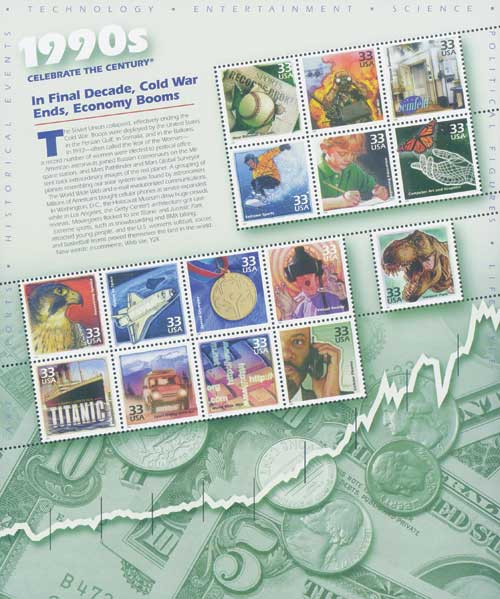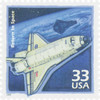
# 3191h - 2000 33c Celebrate the Century - 1990s: Return to Space
US #3191h
2000 Return to Space – Celebrate the Century (1990s)
• Part of the tenth and final sheet in the Celebrate the Century stamp series issued from 1998-2000
• Commemorates John Glenn’s return to space
• Includes text on the back with historical details
Stamp Category: Commemorative
Series: Celebrate the Century
Value: 33¢ First Class Mail Rate
First Day of Issue: May 2, 2000
First Day City: Escondido, California
Quantity Issued: 82,500,000
Printed by: Ashton Potter (USA) Ltd.
Printing Method: Offset, Intaglio
Format: Panes of 15
Perforations: 11.5
Tagging: Block tagging
Why the stamp was issued: To recall John Glenn’s continued importance to the American people and his return to space in 1998.
About the stamp design: Pictures artwork by Drew Struzan of space shuttle Discovery. Includes the following text on the back: “In 1962, aboard the Mercury Friendship 7, John Glenn became the first American to orbit Earth. His 1998 return to space at age 77, on the shuttle Discovery, heightened interest in the space program.”
First Day City: The First Day of Issue Ceremony was held at the Village Amphitheater of San Diego Wild Animal Park in Escondido, California.
About the Celebrate the Century series: The USPS launched the Celebrate the Century series in 1998 to mark the end of the 20th century and herald the arrival of the 21st. The series includes 10 sheets of 15 stamps (150 in total), with each honoring important moments from a different decade (1900s, 10s, 20s, 30s, 40s, 50s, 60s, 70s, 80s, and 90s). At the time of completion, it was the longest and most ambitious commemorative stamp series in US history.
History the stamp represents: Thirty-six years after he blasted into the skies aboard Friendship 7, John Glenn returned to space on October 29, 1998. Glenn, then 77, spent nine days on the shuttle Discovery. A member of the Senate Special Committee on Aging, Glenn hoped his journey would help researchers learn more about the effects of aging.
On February 20, 1962, Glenn became the first American to orbit the Earth. He circled the planet three times in four hours and 55 minutes. Glenn was also the first person to carry a camera into space. He recorded striking images of the Earth, sunrises, and sunsets.
While reading a book on space physiology, the idea occurred to Glenn that a study examining the effects of weightlessness on older people could be beneficial. NASA officials weren’t convinced, and neither was Glenn’s wife, Annie. But after being found in good health, Glenn began preparing for the journey.
Glenn’s heart and respiration rates, blood volume, and blood pressure were monitored regularly throughout the flight. Scientists analyzed the results, especially his immune system function and protein levels. Glenn’s sleep cycles were also measured and compared to readings that were taken before liftoff. He was given another battery of tests when he returned home.
US #3191h
2000 Return to Space – Celebrate the Century (1990s)
• Part of the tenth and final sheet in the Celebrate the Century stamp series issued from 1998-2000
• Commemorates John Glenn’s return to space
• Includes text on the back with historical details
Stamp Category: Commemorative
Series: Celebrate the Century
Value: 33¢ First Class Mail Rate
First Day of Issue: May 2, 2000
First Day City: Escondido, California
Quantity Issued: 82,500,000
Printed by: Ashton Potter (USA) Ltd.
Printing Method: Offset, Intaglio
Format: Panes of 15
Perforations: 11.5
Tagging: Block tagging
Why the stamp was issued: To recall John Glenn’s continued importance to the American people and his return to space in 1998.
About the stamp design: Pictures artwork by Drew Struzan of space shuttle Discovery. Includes the following text on the back: “In 1962, aboard the Mercury Friendship 7, John Glenn became the first American to orbit Earth. His 1998 return to space at age 77, on the shuttle Discovery, heightened interest in the space program.”
First Day City: The First Day of Issue Ceremony was held at the Village Amphitheater of San Diego Wild Animal Park in Escondido, California.
About the Celebrate the Century series: The USPS launched the Celebrate the Century series in 1998 to mark the end of the 20th century and herald the arrival of the 21st. The series includes 10 sheets of 15 stamps (150 in total), with each honoring important moments from a different decade (1900s, 10s, 20s, 30s, 40s, 50s, 60s, 70s, 80s, and 90s). At the time of completion, it was the longest and most ambitious commemorative stamp series in US history.
History the stamp represents: Thirty-six years after he blasted into the skies aboard Friendship 7, John Glenn returned to space on October 29, 1998. Glenn, then 77, spent nine days on the shuttle Discovery. A member of the Senate Special Committee on Aging, Glenn hoped his journey would help researchers learn more about the effects of aging.
On February 20, 1962, Glenn became the first American to orbit the Earth. He circled the planet three times in four hours and 55 minutes. Glenn was also the first person to carry a camera into space. He recorded striking images of the Earth, sunrises, and sunsets.
While reading a book on space physiology, the idea occurred to Glenn that a study examining the effects of weightlessness on older people could be beneficial. NASA officials weren’t convinced, and neither was Glenn’s wife, Annie. But after being found in good health, Glenn began preparing for the journey.
Glenn’s heart and respiration rates, blood volume, and blood pressure were monitored regularly throughout the flight. Scientists analyzed the results, especially his immune system function and protein levels. Glenn’s sleep cycles were also measured and compared to readings that were taken before liftoff. He was given another battery of tests when he returned home.











